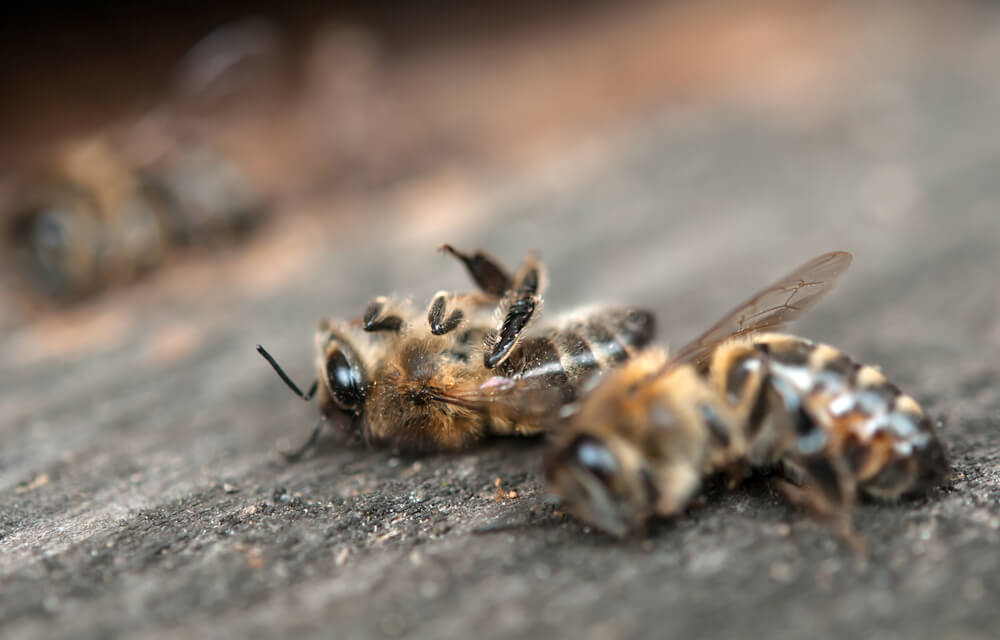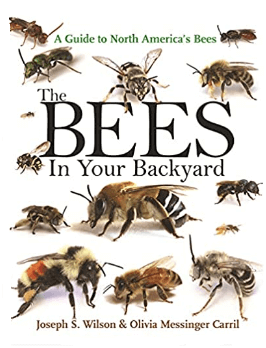Table of Contents:
Why Am I Seeing Dead Bees on the Ground?
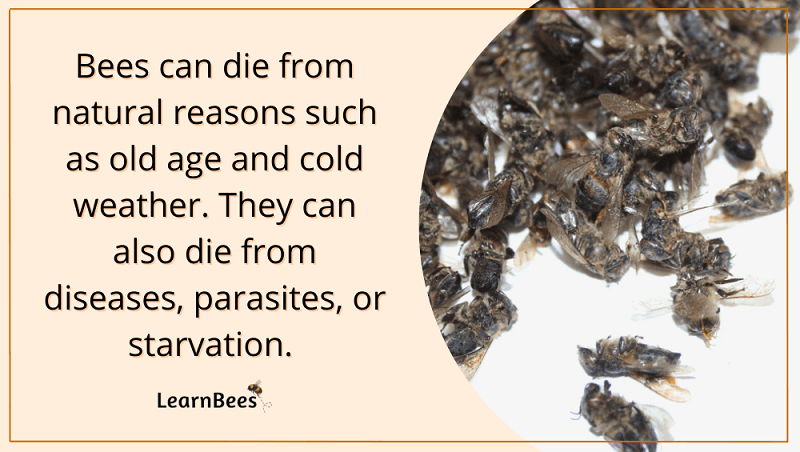
Bees can die from cold weather, disease, parasites, starvation, or simply old age.
If you’re a non-beekeeper, then it’s usually no cause for concern to find dead bees around your yard or garden. The bees likely live around the area, and therefore, that’s where they die.
Now you might be wondering:
But what if I find dead bees inside my house?
In this case, bees could be nesting inside your exterior walls. For example, there have been cases of bees entering a home through a dryer vent or other exterior hole and building their nest inside the walls.
If you’re finding several bees inside your home, then it’s best to contact a local beekeeper to relocate the nest safely. The good news is that beekeepers often perform this service for free to save the bees.
If you’re a beekeeper who has noticed dead bees around the hive, then there could be a few causes, including:
- Bees naturally die throughout the year, and this is especially apparent in the winter
- Bees may die from starvation if they don’t have enough honey stored
- The bees may have been weakened and killed by diseases and pests, such as Varroa mites
- The bees may have been robbed by other bees and wasps, which is common during a nectar dearth
So let’s discuss in more detail why beekeepers lose colonies.
Reason #1: Bees Die in the Winter
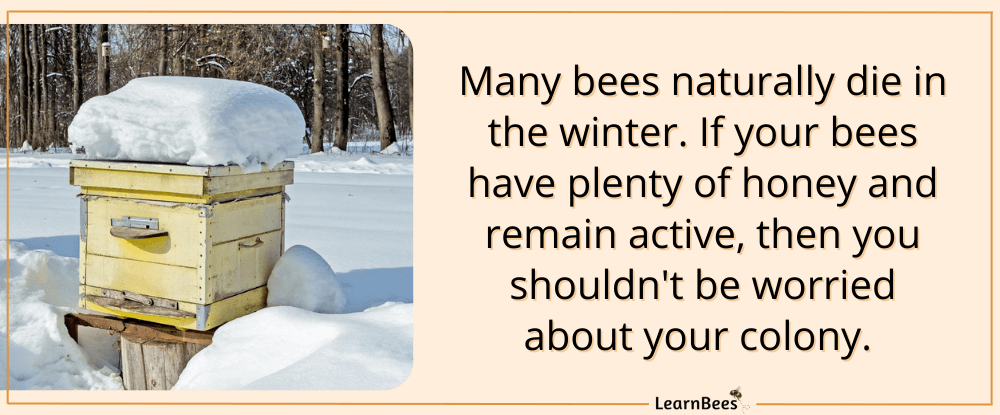
It’s common and normal to find dead bees in the winter.
Many bees will die inside the hive and lay on the bottom board. These dead bees can pile up until the weather warms enough for the worker bees to remove them.
On a warm enough day, the worker bees will begin tossing the dead bees out of the hive to keep things clean. They may drop the bodies on the ground outside or simply drop them on the landing board. It depends on the temperature.
But this is where beekeepers get nervous.
They suddenly see dozens of dead bees out of nowhere and think something is wrong.
Here’s the thing:
These dead bees have likely been piling up all winter long. The worker bees were just waiting for a warm enough day to dump them out.
The bottom line is this:
If your bees have plenty of honey storage and remain active, then you shouldn’t be worried about your colony.
With that said:
We recommend brushing the dead bees off the bottom board first. Next, run your hive tool along the entrance and bottom board to prevent the entrance from getting blocked.
This helps avoid dysentery, which occurs when bees can’t leave the hive to release waste from their bodies. If the waste is released inside the hive, it could lead to unsanitary conditions that kill other bees.
Reason #2: Bees Die From Starvation

Bees need enough food to have plenty of healthy, well-fed bees to generate enough heat to keep the colony warm.
Keep in mind:
A winter colony can burn through its food storage quicker than expected. But as it turns out, bees will eat more on warmer winter days than on cooler ones.
Why?
Because warmer days allow the honey bees to fly around looking for flowers. In most cases, the bees won’t find much food to forage on, and they’ve wasted their precious energy flying for nothing.
But here’s the thing:
Flying bees equals hungry bees.
This explains why warmer winter days result in heavy feeding. In contrast, colder days result in the bees clustering together to stay warm. Clustered bees burn less energy.
And here’s the important part:
You should feed your bees if they’re starving during the winter.
In other words, ignore the people who say you should never open your hive during the winter. It’s never too cold to open a beehive if your colony desperately needs food. If you don’t feed them, they’ll die of starvation.
Yes, you’ll likely lose some bees by opening the hive to feed them. However, that’s better than losing the entire colony due to a lack of food.
Reason #3: Diseases or Pests Killed the Bees
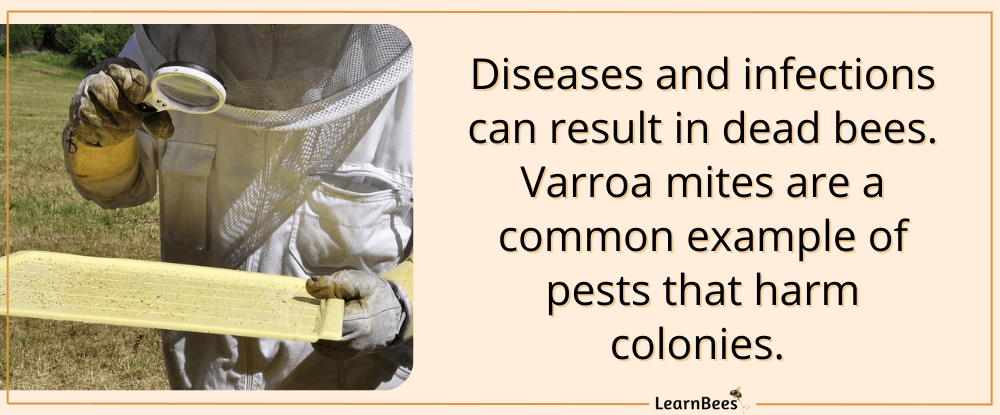
If your bees die even though they have plenty of honey and pollen, it could be a disease problem.
Ask yourself these questions:
Question #1: Do you see dozens of bugs that look like small red dots?
These bugs are called Varroa mites, and they’re often found on the bottom board and capped brood.
Varroa mites reach their highest population in the fall. The number of new bees decreases quickly, but the number of mites steadily increases, so you end up with many more mites per bee.
This is one reason why timely fall mite control is so crucial.
Question #2: Do you notice dead bees that have deformities?
Missing wings or short abdomens can result from a deformed wing virus which is typically spread from varroa.
Question #3: Are the bees greasy, hairy, or black in appearance?
This indicates the bees may have chronic bee paralysis or another disease. To know for sure, you can send them in for testing or ask an expert beekeeper to inspect the hive.
Question #4: Do any of the bees have separated wings that form the shape of the letter K?
This indicates the K-wing virus, which mites can cause.
Question #5: Are the bees dead with their tongues sticking out?
This indicates the bees could’ve died due to pesticide poisoning. The bees can be sent in for testing to confirm.
Reason #4: Robber Bees or Wasps Killed the Colony
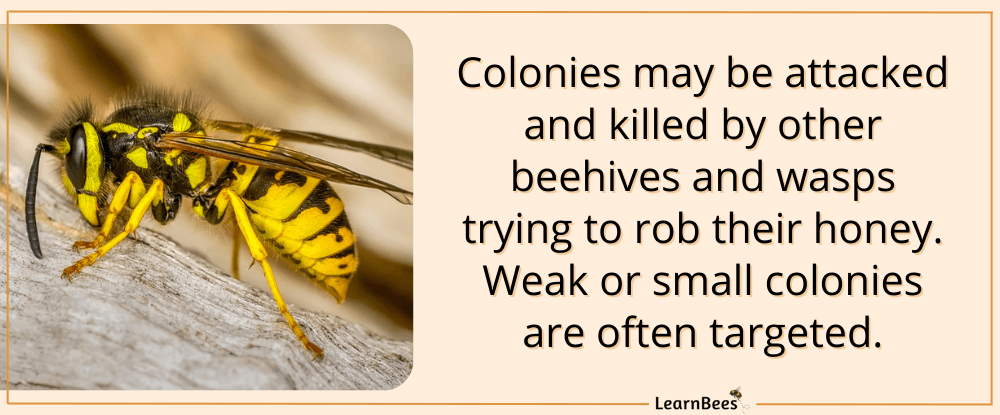
Robbing is a beekeeping term that describes honey bees and wasps that enter other hives to steal their honey.
The robbers rip open capped cells, fill their honey crops, and fly back to their hive. They’ll attack the resident bees to get to the honey, and many bees may die in the process.
Robbing can happen anytime throughout the year, but it’s most common in the late summer or early fall, especially when there is a nectar dearth. Weak or poorly guarded hives are common targets for honey robbers.
Signs of robbing include honey frames that have been stripped clean and bees lying dead around the hive.
Other signs include:
- Bees that appear to be fighting, tumbling, or rolling around the hive. This can occur in the air or landing board. The resident bees are trying to fight off the robbers.
- Wasps often accompany robber bees because they’re attracted to the dead bees and honey.
- The bees may appear shiny, black, and tattered. This happens when the bees lose their body fuzz while fighting.
- Robbing bees typically sway from side to side like wasps because they’re looking for a chance to enter the hive.
- Robbing bees are louder than regular bees.
- Bits of wax comb may be on the landing board as the robbing bees rip open the cells.
What Should You Do With Dead Bees?
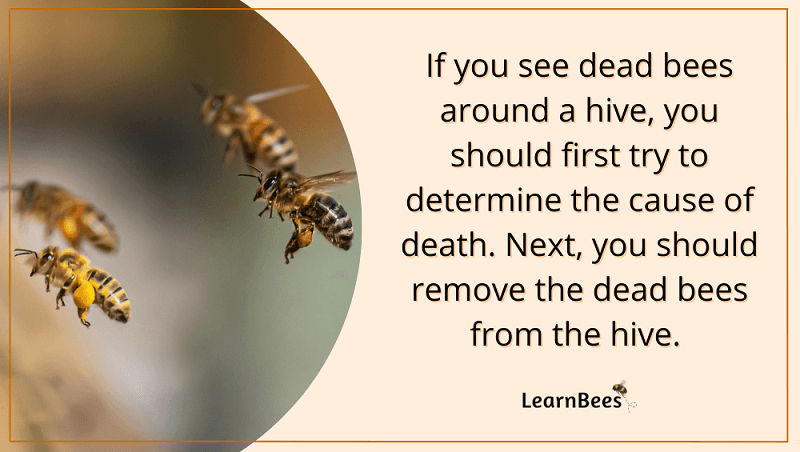
First, you’ll want to determine the cause of death.
If your colony dies from a disease like American Foulbrood, then the hive should be burned to destroy the spores.
However, when a dead hive (that isn’t diseased) is found quickly, most of the honeycomb may be salvageable. In this case, you can harvest honey from this hive as long as the honey seems clean, fresh, and hasn’t been treated with chemicals.
In the meantime, you can dump the dead bees away from other hives so they don’t attract wasps or other critters. Clean the wooden bee boxes with a diluted bleach solution, rinse thoroughly with water, and allow the boxes to air out.
If you’re finding dead bees inside your home, then it could be because there’s a nest in your exterior walls.
Bees sometimes nest inside exterior walls by finding a crack or entry hole inside the home. You can contact a local beekeeper to help relocate the colony without hurting them. Most beekeepers will move the nest for free.
FAQs on Dead Bees
- Why am I finding dead bees around my house?
- Why do I have so many dead bees in my backyard?
- What does it mean when you see dead bees?
- How many dead bees are normal?
- What happens if you touch a dead bee?
- How many dead bees are normal in winter?
- Why do you need to remove dead bees?
- Can bees sense when one of them dies?
- Do dead bees attract more bees?
- What do bees do with dead bees?
- Are dead bees poisonous?
- Why do dead bees still sting?
- Why are there dead bees in the house by the window?
- I keep finding dead bees in the house. What do I do?
Why am I finding dead bees around my house?
This could be due to several reasons, including the bees entering cracks in your home or nesting inside your exterior walls.
If you’re finding dead bees in your house, it’s important to contact a local beekeeper for help. They can safely relocate the colony without hurting them. Most beekeepers will do this for free because it means saving bees.
—> Go back to the FAQs on dead bees
More to Explore:
- What Are Black and Yellow Wasps?
- How Long Do Bumble Bees Live?
- Honeybees vs. Bumblebees: How Do They Compare?
Why do I have so many dead bees in my backyard?
Bees die for various reasons, including natural causes, cold weather, lack of food, and disease. Most people discover dead bumble bees in their yards or gardens. In most cases, this is perfectly normal. Bumble bees probably live around the area, so some will naturally die.
—> Go back to the FAQs on dead bees
More to Explore:
What does it mean when you see dead bees? Why are there a bunch of dead bees in front of my hive?
Seeing dead bees could be completely natural, or it could indicate they died of diseases or starvation. A closer inspection of the dead bees should shed more light on why they died.
—> Go back to the FAQs on dead bees
More to Explore:
How many dead bees are normal?
Bees die every day. It’s estimated that 1,000 bees die daily during the peak warmer months.
That said, wintertime deaths are often more noticeable because their dead bodies collect near the hive. In the summer, when the weather is warm enough to fly, the worker bees will collect the bodies and drop them away from the hive.
—> Go back to the FAQs on dead bees
More to Explore:
What happens if you touch a dead bee?
Sometimes touching a dead bee can result in accidentally touching its stinger. The stinger can get lodged in your skin and inject venom like a regular sting from a living bee.
—> Go back to the FAQs on dead bees
More to Explore:
- How to Repel Bees Without Killing Them
- Carpenter Bee vs. Bumble Bee
- The Best Essential Oils for Bee Stings
How many dead bees are normal in the winter?
It’s normal to lose between 150 to 250 bees per day in the winter.
So a healthy colony can have 50,000 or more bees going into the fall but may have only 20,000 come spring. This means they lost 30,000 bees during the winter.
—> Go back to the FAQs on dead bees
More to Explore:
- Wasps vs. Honey Bees: Are They Different?
- Are Worker Bees Male or Female?
- Queen Bee Versus Worker Bees – How Do They Compare?
Why do you need to remove dead bees? Should I remove dead bees from the hive?
You should clear the dead bees off the bottom board and run your hive tool along the entrance to ensure it’s not blocked with dead carcasses.
Removing dead bees from the hive helps reduce the risk of disease and parasites.
—> Go back to the FAQs on dead bees
More to Explore:
- Do Wasps Make Honey?
- What’s the Difference Between Wasps, Hornets, and Bees?
- Wasp Nest vs. Bee Nest: Which One Is It?
Can bees sense when one of them dies?
Yes, bees can tell when a bee has died. Worker bees will remove dead bees from the nest to prevent the buildup of dead bodies and to keep things sanitary.
—> Go back to the FAQs on dead bees
More to Explore:
Do dead bees attract more bees?
Dead bees typically don’t attract other bees. The exception is that dead or dying queen bees will alert the attention of the worker bees. This is because queen honey bees are necessary for the colony’s survival, so if the worker bees sense she’s dying or weak, they’ll quickly work to replace her.
—> Go back to the FAQs on dead bees
More to Explore:
What do bees do with dead bees?
Worker bees remove dead bees from the nest to keep the area clean.
—> Go back to the FAQs on dead bees
More to Explore:
Are dead bees poisonous?
Dead bees are not poisonous. However, if you touch their stinger, then you may accidentally get pricked and injected with venom – despite the bee being dead.
—> Go back to the FAQs on dead bees
Why do dead bees still sting?
The stinger of a dead bee can still sting if touched because the venom sac is attached to the stinger.
—> Go back to the FAQs on dead bees
Why are there dead bees in the house by the window?
Dead bees in your house or window sill could indicate that they are entering through cracks. Make sure you tightly seal any openings around windows and doors to ensure that bees cannot enter. You can also contact a beekeeper to remove any colonies from your property.
—> Go back to the FAQs on dead bees
I keep finding dead bees in the house. What do I do?
If you’re finding dead bees inside your home, it could indicate that there is an active colony nearby or inside the exterior walls of your home.
Contact a beekeeper to come and inspect the area and determine the best course of action. They can help you identify the hive’s location, remove it, and ensure that your home is bee-proofed to prevent future invasions.
Keep in mind that bees are important for our environment, so beekeepers often perform nest relocations for free.
